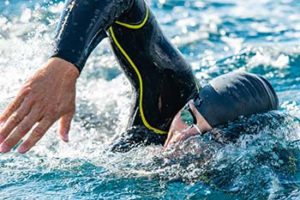 If you have been swimming for any length of time you have likely heard the term ‘bilateral breathing.’ Most typically, you will see bilateral breathing when a swimmer breathes on an odd number strokes, every third stroke for instance. More generally, bilateral breathing refers to the ability to breathe to both the left and the right side.
If you have been swimming for any length of time you have likely heard the term ‘bilateral breathing.’ Most typically, you will see bilateral breathing when a swimmer breathes on an odd number strokes, every third stroke for instance. More generally, bilateral breathing refers to the ability to breathe to both the left and the right side.
One of the most common questions asked by swimmers, and especially newer swimmers, is, “Should I breathe to both sides when I swim?”
The short answer is yes, you should absolutely learn how to breathe to both sides and you should use that bilateral breathing skill . . . sometimes.
THE CASE FOR BILATERAL BREATHING
Let’s start with the obvious; nearly all swimmers start out predominately breathing to one side. Breathing to the other side feels awkward, difficult and maybe even uncomfortable. Often times, instead of developing the bilateral breathing skill, they ignore it. I mean really, who wants to be uncomfortable in the water?
Technique Flaws
The problem with breathing exclusively to one side is that, over time, you’ll roll just a little bit further to your breathing side than to your non-breathing side. The average age-group triathlete takes roughly 60 stokes per minute. That means in an hour of swimming, you may roll to your breathing side as many as 1,800 times. That leads to uneven muscle development in your core resulting in a lopsided stroke. Multiply that by thousands of hours swimming and you see how the technique flaw can become permanent. Having a permanent flaw that causes you to pull towards one side isn’t such a big deal when there is a line on the bottom of the pool. In the open water, where there isn’t a nice big line to keep you on course, not swimming straight suddenly becomes a major concern.
Breathing bilaterally helps to create symmetry in your stroke. That gives you a balanced, more efficient stroke.
Advantage on Race Day
Going beyond stroke technique, consider a race I once competed in. The swim was held in a lake. It went east from a start on the beach, out 125 meters around a buoy then north parallel to the beach 250 meters to a buoy. It then retraced the same course back to the starting point. On the day of this race, there was an east wind of about 20 mph generating 2 foot wind waves. The start of the race happened to coincide with the sunrise.
If I were only able to breathe to my right side, I would have had difficulty on the way out. The wind waves would have been coming from my right side, making a clean breath very difficult. The sun would have been in my eyes, adding to the difficulty. Finally, because the shore was on my left, I would have had to develop some other strategy for sighting and staying on course. However, if I were able to breathe to either side, I could have utilized my bilateral breathing skill by breathing to the left side on the way out. I would have avoided the waves and the sun. I would have also been able to sight the shore and not had to resort to a less efficient method of sighting to stay on course.
Another advantage of bilateral breathing is it gives you options during a mass start. In a crowded mass start you may be able to breathe on one side and not at all on the other.
Breathing bilaterally adds a very effective tool to help your swim on race day.
THE CASE AGAINST BILATERAL BREATHING
Triathlon, and specifically the triathlon swim, is largely an aerobic endeavor. That is not to say that triathletes are never anaerobic. However, the majority of age-group triathletes, will remain aerobic during the swim. That means that oxygen is your friend and the more oxygen the better. Most triathletes, at maximal exertion, are drawing between 50 and 60 respirations per minute. If you breathe bilaterally, you are drawing only 20 breaths per minute – one third of your body’s preferred rate. On the other hand, if you are breathing to a single side, you are drawing 30 breaths per minute. That’s 50% more oxygen than if you are breathing bilaterally! You still are not breathing at your body’s preferred rate, but are nonetheless, taking in far more oxygen.
More oxygen means your swim threshold pace is going to be just a little bit faster. You can verify this in training by doing an STP test on one day while breathing bilaterally – using the results to set your training intervals. At your next workout, do another STP test breathing to one side – using those results to set race paces. You will likely see a 1-2 second difference in STP breathing bilaterally vs. breathing to a single side. That’s not a significant difference over a triathlon swim unless you are competing for a podium finish. However, understanding the difference can have you come out of the water better prepared for the bike and swim.
SUMMARY
All things considered, your swim fitness will have more influence upon your performance in an event than the ability to breathe bilaterally. However, breathing bilaterally can have a lasting impact upon your stroke technique, which will ultimately trump swim fitness. Breathing bilaterally during workouts is a good way to develop the skill and promote good stroke technique. I recommend to the athletes I work with that they breathe bilaterally during warm-up and for 30-50% of their main sets.
During triathlon swims, the primary energy pathway is the aerobic system. The aerobic system uses oxygen so breathing patterns become very important. By breathing to only one side during a race, an athlete can increase their oxygen intake over breathing bilaterally by as much as 50%.
During training, breathe bilaterally to develop and maintain a balanced stroke. During races, breathe to one side to provide more oxygen to the aerobic energy system.
